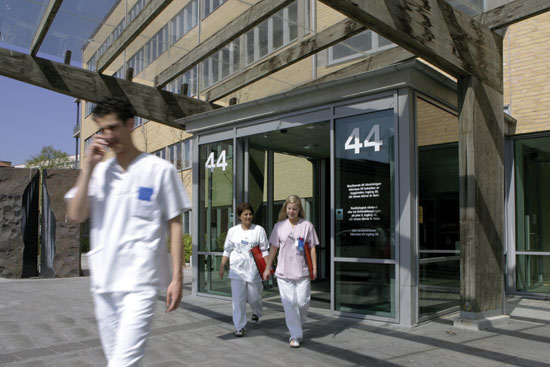Door Opening Solutions in LEED for Healthcare
Learning Objectives:
- Identify and recognize the green criteria that make-up LEED® for Healthcare related to door openings.
- Investigate the multiple ways that exterior door opening solutions can contribute to Energy and Atmosphere (EA) credits in LEED® for Healthcare.
- Assess the potential for door opening materials to contribute to Materials and Resources (MR) credits in LEED® for Healthcare.
- Specify total door opening solutions that are consistent with Indoor Environmental Quality (IEQ) standards in LEED® for Healthcare.
Credits:
The USGBC LEED Green Building Rating System™ is recognized as the leading nationally accepted benchmark for the design, construction, and operation of a growing family of high-performance green building types, including healthcare facilities. While LEED for Healthcare promotes a whole-building approach to sustainability, a significant supporting component can be found in high-performance commercial doors and their related opening elements. All LEED systems currently recognize performance in the seven key areas of sustainable sites, water efficiency, energy and atmosphere, materials and resources, indoor environmental quality, innovation in design, and regional priority credits. High-performance door openings can contribute to credits in at least three of them: energy and atmosphere, materials and resources, and indoor environmental quality.
The Green Standard for Healthcare
The LEED for Healthcare rating system represents a culmination of seven years of close collaboration between the USGBC and the Green Guide for Healthcare (GGHC). The GGHC developed the first voluntary, self-certifying toolkit of green building best practices customized for the healthcare sector. GGHC has helped to streamline the LEED for Healthcare's development schedule by aligning with the LEED for New Construction rating system's organizational structure.
LEED for Healthcare begins by recognizing that the needs of healthcare facilities are very unique. Healthcare buildings often have strict regulatory requirements, 24/7 operations, and specific programmatic demands that are not covered in other LEED rating systems. Hence, the LEED for Healthcare rating system acknowledges these differences by both modifying existing credits and creating new, healthcare-specific credits. The goal is to help promote healthful, durable, affordable, and environmentally sound practices in these healthcare-centered projects.
 |
Green building design for healthcare facilities is enhanced by proper attention to all aspects of door openings. Photo courtesy of ASSA ABLOY |
LEED for Healthcare is geared towards inpatient and outpatient care facilities plus licensed long-term care facilities. It can also be used for medical offices, assisted living facilities, and medical education and research centers. Projects that meet certain criteria are often required to use LEED for Healthcare such as licensed and federal inpatient and outpatient care facilities and licensed long-term care facilities.
LEED for Healthcare addresses design and construction activities for both new buildings and major renovations of existing buildings. A major renovation involves major HVAC renovation, significant envelope modifications, and major interior rehabilitation. For a major renovation of an existing building, LEED for Healthcare is the appropriate rating system. If the project scope does not involve significant design and construction activities and focuses more on operations and maintenance activities, LEED for Existing Buildings: Operations & Maintenance is more appropriate because it addresses operational and maintenance issues of working buildings.
 |
Energy and Atmosphere credits in LEED for Healthcare are dramatically affected by door openings in the building envelope. Photo courtesy of ASSA ABLOY |
As with all LEED rating systems, earning LEED for Healthcare certification requires that the applicant project must satisfy all the prerequisites and qualify for a minimum number of points to attain the certification level being pursued. Having satisfied the basic prerequisites of the program, applicant projects are rated according to their degree of compliance within the rating system up to a total of 100 base points available plus 6 possible Innovation in Design and 4 Regional Priority points:
• Certified: 40-49 points
• Silver: 50-59 points
• Gold: 60-79 points
• Platinum: 80+ points
The three primary certification categories where high-performance doors and hardware can have a meaningful impact are:
• Energy and Atmosphere (EA)
• Materials and Resources (MR)
• Indoor Environmental Quality (IEQ)
We will discuss each of these at length as we look at how door opening solutions can assist LEED Healthcare projects in achieving points within the applicable credits.










